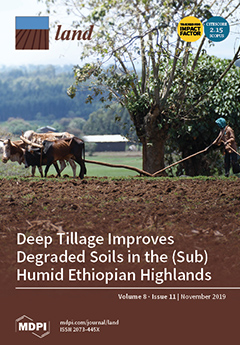Resources
Displaying 1636 - 1640 of 2258How Much is Enough? Improving Participatory Mapping Using Area Rarefaction Curves
Participatory mapping is a valuable approach for documenting the influence of human activities on species, ecosystems, and ecosystem services, as well as the variability of human activities over space and time. This method is particularly valuable in data-poor systems; however, there has never been a systematic approach for identifying the total number of respondents necessary to map the entire spatial extent of a particular human activity. Here, we develop a new technique for identifying sufficient respondent sample sizes for participatory mapping by adapting species rarefaction curves.
Deep Tillage Improves Degraded Soils in the (Sub) Humid Ethiopian Highlands
Intensification of rainfed agriculture in the Ethiopian highlands has resulted in soil degradation and hardpan formation, which has reduced rooting depth, decreased deep percolation, and increased direct runoff and sediment transport. The main objective of this study was to assess the potential impact of subsoiling on surface runoff, sediment loss, soil water content, infiltration rate, and maize yield.
Law, Violence, and Property Expropriation in Syria: Impediments to Restitution and Return
After eight years of civil war, parts of Syria are now free from conflict. In recognition of the return to peace, the government officially welcomes back all who fled the country to escape violence. Yet, a pattern of property expropriation supported by the government during the war limits the ability of some to return and reclaim their homes and businesses.
‘Not One More Bloody Acre’: Land Restitution and the Treaty of Waitangi Settlement Process in Aotearoa New Zealand
Te Tiriti o Waitangi, signed between Māori rangatira (chiefs) and the British Crown in 1840 guaranteed to Māori the ‘full, exclusive and undisturbed possession of their lands’. In the decades that followed, Māori were systematically dispossessed of all but a fraction of their land through a variety of mechanisms, including raupatu (confiscation), the individualisation of title, excessive Crown purchasing and the compulsory acquisition of land for public works.
REDD+ Implementation in Community-Based Muyong Forest Management in Ifugao, Philippines
Ifugao province of the Philippines has a traditional muyong forest system that supplies water and prevents soil erosion of the world-famous Ifugao rice terraces. The socio-political structure of Ifugao has been the key to the maintenance and communal use of land, as well as the muyong forest, without causing excessive damage to the land. Recently, the Ifugao is facing various challenges viz. deforestation, slash-and-burn, introduction of commercial rice, and climate change.


